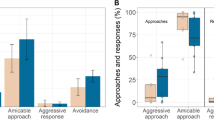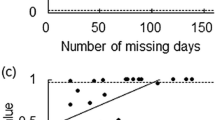Abstract
Estrous synchrony in seasonal breeders can in principle be based on and shaped by environmental, internal, and/or social cues. We analyzed the dynamics of estrous synchrony for the first time in a seasonal, nocturnal primate species, the gray mouse lemur (Microcebus murinus). We compared successive estrous cycles and different levels of spatial proximity over two reproductive seasons in a captive population in order to identify possible social influences on estrous synchrony. The females exhibited a marked estrous synchrony at the beginning of each reproductive season, but we found no indication of a process of socially induced synchronization among them. Females housed in the same cage/room were not more strongly synchronized than females housed in different cages/rooms. Moreover, cycles desynchronized from the first to the second estrus of the season. Estrous cycle length did not depend on age, parity, or social housing conditions, but instead mainly on the individuality of the lemurs. This individuality, shown for the first time in a nocturnal primate species, is likely to be based on an endogenous rhythm with a genetic basis. We discuss possible social advantages, e.g., communal rearing, and disadvantages, e.g., mate choice and female-female competition, of estrous synchrony for nocturnal primates living in a dispersed individualized social network, and propose that a moderate flexibility within the individual cycle lengths probably enables the females to compromise between the different socioecological pressures.
Similar content being viewed by others
REFERENCES
Andriantsiferana, R., Rarijaona, Y., and Randrianaivo, A. (1974). Observations sur la reproduction du microcèbe (Microcebus murinus, Miller 1777) en captivité a Tananarive. Mammalia 38: 234–243.
Boinski, S. (1987). Birth synchrony in squirrel monkey (Saimiri oerstedi). Behav. Ecol. Sociobiol. 21: 393–400.
Buesching, C. D., Heistermann, M., Hodges, J. K., and Zimmermann, E. (1998). Multimodal estrous advertisement in a small nocturnal prosimian, Microcebus murinus. Folia Primatol. 69(suppl. 1): 295–308.
Darling, F. F. (1938). Bird flocks and breeding cycle. Cambridge University Press, Cambridge.
Dixson, A. F. (1998). Primate Sexuality, Oxford University Press, Oxford.
Dunbar, R. I. M. (1980). Demographic and life history variables of a population of gelada baboons (Theropithecus gelada). J. Anim. Ecol. 49: 485–506.
Emlen, S. T., and Oring, L. W. (1977). Ecology, sexual selection, and the evolution of mating systems. Science 197: 215–223.
French, J. A., and Stribley, J. A. (1987). Synchronization of ovarian cycles within and between social groups in golden lion tamarins (Leontopithecus rosalia). Am. J. Primatol. 12: 469–478.
Garey, J. D. (1991). Breeding cyclicity in wild and captive vervet monkeys. Am. J. Phys. Anthropol. Suppl. 12: 75.
Glatston, A. R. (1986). The influence of other females on maternal behaviour and breeding success in the lesser mouse lemur (Microcebus murinus). In Else, J. G., and Lee, P. C. (eds.), Primate Ontogeny, Cognition, and Social Behaviour, Cambridge University Press, Cambridge, pp. 355–361.
Glatston, A. R. H. (1979). Reproduction and behaviour of the lesser mouse lemur (Microcebus murinus, Miller 1777) in captivity. Ph.D. thesis, University of London.
Halliday, T. R. (1983). The study of mate choice. In Bateson, P. (ed.), Mate Choice, Cambridge University Press, Cambridge, pp. 3–32.
Ims, R. A. (1990a). The ecology and evolution of reproductive synchrony. TREE 5: 135–141.
Ims, R. A. (1990b). On the adaptive values of reproductive synchrony as a predator-swamping strategy. Am. Nat. 136: 485–498.
Jolly, A. (1967). Breeding synchrony in wild Lemur catta. In Altmann, S. A. (ed.), Social Communication among Primates, University of Chicago Press, Chicago, pp. 3–14.
Jolly, A. (1984). The puzzle of female feeding priority. In Small, M. F. (ed.), Female Primates: Studies by Woman Primatologists, Alan R. Liss, New York, pp. 197–215.
Kappeler, P. M., and Ganzhorn, J. U. (1993). The evolution of primate communities and societies in Madagascar. Evolutionary Anthropology 2: 159–171.
Kavanagh, M. (1983). Birth seasonality in Cercopithecus aethiops. A social advantage from synchrony? In Seth, P. K. (ed.), Perspectives in Primate Biology, Today & Tomorrow's Printers and Publishers, New Delhi, pp. 89–98.
Lebec, A. (1984). Relation entre le comportement agressif du Microcèbe mâle, les autres comportements et la physiologie sexuelle. Rôle de quelques facteurs déterminants. Thèse 3ème Cycle, Université de Paris VI.
Martin, R. D. (1972). A preliminary field-study of the lesser mouse lemur (Microcebus murinus J. F. Miller 1777). Z. Tierpsychol. 9: 43–89.
McClintock, M. K. (1971). Menstrual synchrony and suppression. Nature 229: 244–245.
McClintock, M. K. (1983). Pheromonal regulation of the ovarian cycle: Enhancement, suppression, and synchrony. In Vandenbergh, J. G. (ed.), Pheromones and Reproduction in Mammals, Academic Press, New York, London, pp. 113–149.
Mittermeier, R. A., Tattersall, I., Konstant, W. R., Meyers, D. M., and Mast, R. B. (1994). Lemurs of Madagascar, Conservation International, Washington, DC.
Pages, E., and Petter-Rousseaux, A. (1980). Annual variations in the circadian activity rhythms of five sympatric species of nocturnal prosimians in captivity. In Charles-Dominique, P., Cooper, H. M., Hladik, A., Hladik, C. M., Pariente, G. F., Petter-Rousseaux, A., and Schilling, A. (eds.), Nocturnal Malagasy Primates, Academic Press, New York, pp. 153–167.
Pereira, M. E. (1991). Asynchrony within estrous synchrony among ringtailed lemurs (Primates: Lemuridae). Physiol. Behav. 49: 47–52.
Perret, M. (1977). Influence du groupement social sur l'activation sexuelle saisonnière chez le male de Microcebus murinus (Miller 1777). Z. Tierpsychol. 43: 159–179.
Perret, M. (1982). Influence du groupement social sur la reproduction de la femelle de Microcebus murinus (Miller, 1777). Z. Tierpsychol. 60: 47–65.
Perret, M. (1986). Social influences on oestrous cycle length and plasma progesterone concentrations in the female lesser mouse lemur (Microcebus murinus). J. Reprod. Fert. 77: 303–311.
Perret, M. (1992). Environmental and social determinants of sexual function in the male lesser mouse lemur (Microcebus murinus). Folia Primatol. 59: 1–25.
Petter, J.-J., Albignac, R., and Rumpler, Y. (1977). Faune de Madagascar, ORSTROM CNRS, Paris.
Petter-Rousseaux, A. (1968). Cycles genitaux saisonniers des lemuriens malgaches. In Canivenc, R. (ed.), Cycles genitaux saisonniers de Mammife`res sauvages, Masson et Cie, Paris, pp. 11–22.
Petter-Rousseaux, A. (1975). Activité sexuelle de Microcebus murinus (Miller, 1777) soumis à des régimes photopériodiques expérimentaux. Ann. Biol. Anim. Bioch. Biophys. 15: 503–508.
Petter-Rousseaux, A. (1980). Seasonal activity rhythms, reproduction, and body weight variations in five sympatric nocturnal prosimians, in simulated light and climatic conditions. In Charles-Dominique, P., Cooper, H. M., Hladik, A., Hladik, C. M., Pariente, G. F., Petter-Rousseaux, A., and Schilling, A. (eds.), Nocturnal Malagasy Primates, Academic Press, New York, pp. 137–152.
Radespiel, U. (1998). Die soziale Organisation des grauen Mausmakis (Microcebus murinus, J. F. Miller 1777)—Eine freilandökologische und laborexperimentelle Studie. Ph.D. thesis, University of Hanover, Verlag Dr. Köster, Berlin.
Radespiel, U. (2000). Sociality in the gray mouse lemur (Microcebus murinus) in northwestern Madagascar. Am. J. Primatol. 51: 21–40.
Radespiel, U., Cepok, S., Zimmermann, E., and Zietemann, V. (1998). Sex-specific usage patterns of sleeping-sites in Grey Mouse Lemurs (Microcebus murinus) in Northwestern Madagascar. Am. J. Primatol. 46: 77–84.
Rasmussen, D. T. (1985). A comparative study of breeding seasonality and litter size in eleven taxa of captive lemurs (Lemur and Varecia) Int. J. of Primatol. 6: 501–517.
Richard, A. (1978). Behavioral Variation: Case Study of aMalagasy Lemur, Bucknell University Press, Lewisburg, PA.
Richard, A. F., and Dewar, R. E. (1991). Lemur ecology. Ann. Rev. Ecol. Syst. 22: 145–175.
Ridley, M. (1986). The number of males in a primate troop. Anim. Behav. 34: 1848–1858.
Rood, J. P. (1978). Dwarf mongoose helpers at the den. Z. Tierpsychol. 48: 277–287.
Rowell, T. E., and Richards, S. M. (1979). Reproductive strategies of some African monkeys. J. Mammal. 60: 58–69.
Rutberg, A. T. (1987). Adaptive hypotheses of birth synchrony in ruminants: an interspecific test. Am. Nat. 130: 692–710.
Schapiro, S. J. (1985). Reproductive seasonality: Birth synchrony as female-female reproductive competition and cooperation in captive Cercopithecus aethiops and C. mitis. Ph.D. thesis, University of California, Davis.
Schmelting, B., Ehresmann, P., Lutermann, H., Randrianambinina, B., and Zimmermann, E. (2000). Reproduction of two sympatric mouse lemur species (Microcebus murinus and M. ravelobensis) in north-west Madagascar: First results of a long term study. In Lourenço, W. R., and Goodman, S. M. (eds.), Diversity and Endemism in Madagascar, Mémoires de la Societé de Biogéographie, Paris, pp. 1–12.
Silk, J. B. (1989). Reproductive synchrony in captive macaques. Am. J. Primatol. 19: 137–146.
Small, M. F. (1990). Promiscuity in Barbary macaques. Am. J. Primatol. 20: 278–282.
Sokal, R. R., and Rohlf, F. J. (1981). Biometry, W. H. Freeman and Company, New York.
Tattersall, I. (1982). The Primates of Madagascar, Columbia University Press, New York.
Trivers, R. L. (1972). Parental investment and sexual selection. In Campbell, B. (ed.), Sexual Selection and the Descent of Man 1871–1971, Aldine, Chicago, pp. 136–179.
van Schaik, C. P., and van Hooff, J. A. R. A. M. (1983). On the ultimate causes of primate social systems. Behaviour 85: 91–117.
Wallis, J. (1985). Synchrony of estrous swelling in captive group-living chimpanzees (Pan troglodytes). Int. J. Primatol. 6: 335–350.
Wrogemann, D., Radespiel, U., and Zimmermann, E. (2000). Comparison of reproductive characteristics between captive populations of rufous and gray mouse lemurs. Int. J. of Primatol.
Wrogemann, D., and Zimmermann, E. (in press). Aspects of reproduction in the rufous mouse lemur (Microcebus rufus) and its implications for captive management. Zoo Biol.
Zimmermann, E. (1995). Acoustic communication in nocturnal prosimians. In Izard, K., Alterman, L., and Doyle, G. A. (eds.), Creatures of the Dark, Plenum Press, New York, pp. 311–330.
Author information
Authors and Affiliations
Corresponding author
Rights and permissions
About this article
Cite this article
Radespiel, U., Zimmermann, E. Dynamics of Estrous Synchrony in Captive Gray Mouse Lemurs (Microcebus murinus). International Journal of Primatology 22, 71–90 (2001). https://doi.org/10.1023/A:1026466015443
Issue Date:
DOI: https://doi.org/10.1023/A:1026466015443




